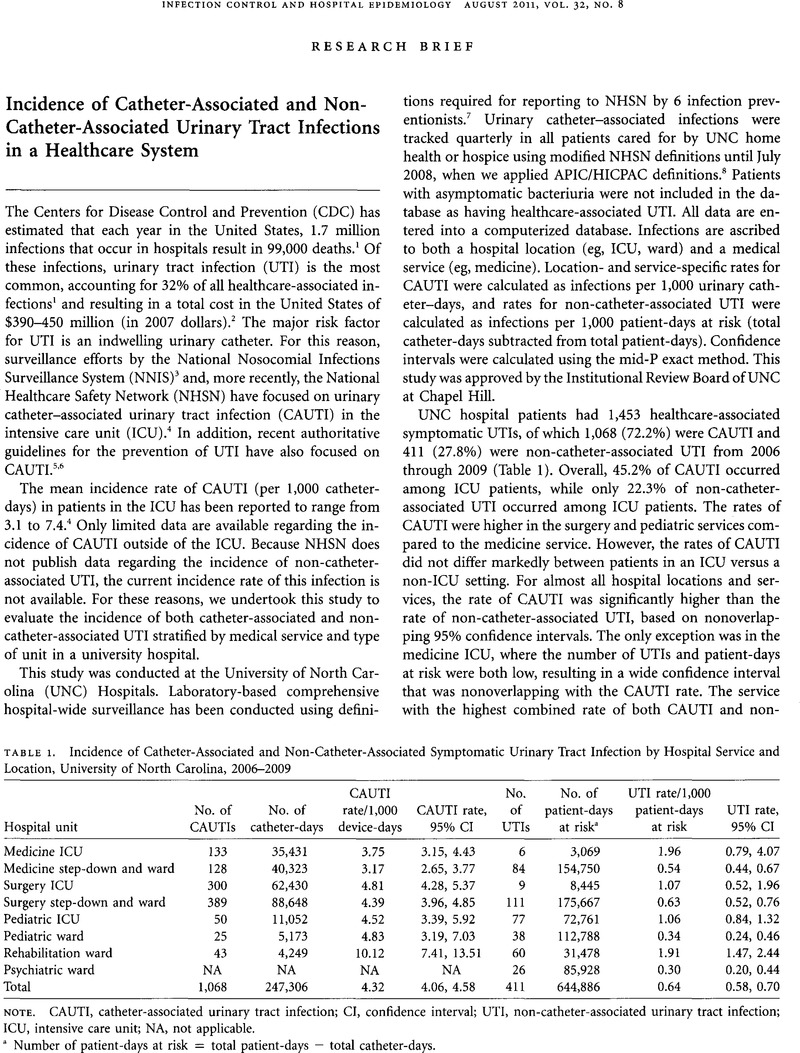Crossref Citations
This article has been cited by the following publications. This list is generated based on data provided by Crossref.
Weber, David J.
Kang, JaHyun
Brown, Vickie M.
Sickbert-Bennett, Emily E.
and
Rutala, William A.
2012.
Preventing Catheter-Associated Urinary Tract Infections: Hospital Location of Catheter Insertion.
Infection Control & Hospital Epidemiology,
Vol. 33,
Issue. 10,
p.
1057.
Lewis, Sarah S.
Knelson, Lauren P.
Moehring, Rebekah W.
Chen, Luke F.
Sexton, Daniel J.
and
Anderson, Deverick J.
2013.
Comparison of Non–Intensive Care Unit (ICU) versus ICU Rates of Catheter-Associated Urinary Tract Infection in Community Hospitals.
Infection Control & Hospital Epidemiology,
Vol. 34,
Issue. 7,
p.
744.
Chenoweth, Carol
and
Saint, Sanjay
2013.
Preventing Catheter-Associated Urinary Tract Infections in the Intensive Care Unit.
Critical Care Clinics,
Vol. 29,
Issue. 1,
p.
19.
Greene, M. Todd
Fakih, Mohamad G.
Fowler, Karen E.
Meddings, Jennifer
Ratz, David
Safdar, Nasia
Olmsted, Russell N.
and
Saint, Sanjay
2014.
Regional Variation in Urinary Catheter Use and Catheter-Associated Urinary Tract Infection: Results from a National Collaborative.
Infection Control & Hospital Epidemiology,
Vol. 35,
Issue. S3,
p.
S99.
Jordan, Rachael P.C.
and
Nicolle, Lindsay E.
2014.
Biofilms in Infection Prevention and Control.
p.
287.
Lo, Evelyn
Nicolle, Lindsay E.
Coffin, Susan E.
Gould, Carolyn
Maragakis, Lisa L.
Meddings, Jennifer
Pegues, David A.
Pettis, Ann Marie
Saint, Sanjay
and
Yokoe, Deborah S.
2014.
Strategies to Prevent Catheter-Associated Urinary Tract Infections in Acute Care Hospitals: 2014 Update.
Infection Control & Hospital Epidemiology,
Vol. 35,
Issue. S2,
p.
S32.
Lo, Evelyn
Nicolle, Lindsay E.
Coffin, Susan E.
Gould, Carolyn
Maragakis, Lisa L.
Meddings, Jennifer
Pegues, David A.
Pettis, Ann Marie
Saint, Sanjay
and
Yokoe, Deborah S.
2014.
Strategies to Prevent Catheter-Associated Urinary Tract Infections in Acute Care Hospitals: 2014 Update.
Infection Control & Hospital Epidemiology,
Vol. 35,
Issue. S2,
p.
S32.
Lo, Evelyn
Nicolle, Lindsay E.
Coffin, Susan E.
Gould, Carolyn
Maragakis, Lisa L.
Meddings, Jennifer
Pegues, David A.
Pettis, Ann Marie
Saint, Sanjay
and
Yokoe, Deborah S.
2014.
Strategies to Prevent Catheter-Associated Urinary Tract Infections in Acute Care Hospitals: 2014 Update.
Infection Control & Hospital Epidemiology,
Vol. 35,
Issue. 5,
p.
464.
Chenoweth, Carol E.
Gould, Carolyn V.
and
Saint, Sanjay
2014.
Diagnosis, Management, and Prevention of Catheter-Associated Urinary Tract Infections.
Infectious Disease Clinics of North America,
Vol. 28,
Issue. 1,
p.
105.
Baier, C.
and
Chaberny, Iris F.
2015.
Prävention Katheter-assoziierter Harnwegsinfektionen: Bewährtes und Neues für den klinischen Alltag.
Der Anaesthesist,
Vol. 64,
Issue. 12,
p.
953.
Zhang, Peng
Hu, Wan-Li
Cheng, Bei
Cheng, Long
Xiong, Xiao-Kan
and
Zeng, Yang-Jun
2015.
A systematic review and meta-analysis comparing immediate and delayed catheter removal following uncomplicated hysterectomy.
International Urogynecology Journal,
Vol. 26,
Issue. 5,
p.
665.
Thakur, Archana
Jain, Manisha
Dogra, Vinita
Mishra, Bibhabati
and
Loomba, Poonam Sood
2015.
Knowledge and attitude of doctors and nurses regarding indication for catheterization and prevention of catheter-associated urinary tract infection in a tertiary care hospital.
Indian Journal of Critical Care Medicine,
Vol. 19,
Issue. 2,
p.
76.
Jordan, Rachael PC
Malic, Sladjana
Waters, Mark G
Stickler, David J
and
Williams, David W
2015.
Development of an antimicrobial urinary catheter to inhibit urinary catheter encrustation.
Microbiology Discovery,
Vol. 3,
Issue. 1,
p.
1.
von Homeyer, Peter
2015.
Modern Concepts and Practices in Cardiothoracic Critical Care.
p.
517.
Barbadoro, Pamela
Labricciosa, Francesco M.
Recanatini, Claudia
Gori, Giada
Tirabassi, Federico
Martini, Enrica
Gioia, Maria Grazia
D'Errico, Marcello M.
and
Prospero, Emilia
2015.
Catheter-associated urinary tract infection: Role of the setting of catheter insertion.
American Journal of Infection Control,
Vol. 43,
Issue. 7,
p.
707.
Blodgett, Tom J.
Gardner, Sue E.
Blodgett, Nicole P.
Peterson, Lisa V.
and
Pietraszak, Melissa
2015.
A Tool to Assess the Signs and Symptoms of Catheter-Associated Urinary Tract Infection.
Clinical Nursing Research,
Vol. 24,
Issue. 4,
p.
341.
Hooton, Thomas M.
2015.
Mandell, Douglas, and Bennett's Principles and Practice of Infectious Diseases.
p.
3334.
Zubkoff, Lisa
Neily, Julia
King, Beth J.
Dellefield, Mary Ellen
Krein, Sarah
Young-Xu, Yinong
Boar, Shoshana
and
Mills, Peter D.
2016.
Virtual Breakthrough Series, Part 1: Preventing Catheter-Associated Urinary Tract Infection and Hospital-Acquired Pressure Ulcers in the Veterans Health Administration.
The Joint Commission Journal on Quality and Patient Safety,
Vol. 42,
Issue. 11,
p.
485.
Chenoweth, Carol E.
and
Saint, Sanjay
2016.
Urinary Tract Infections.
Infectious Disease Clinics of North America,
Vol. 30,
Issue. 4,
p.
869.
Melo, Luís D. R.
Veiga, Patrícia
Cerca, Nuno
Kropinski, Andrew M.
Almeida, Carina
Azeredo, Joana
and
Sillankorva, Sanna
2016.
Development of a Phage Cocktail to Control Proteus mirabilis Catheter-associated Urinary Tract Infections.
Frontiers in Microbiology,
Vol. 7,
Issue. ,





